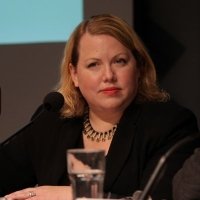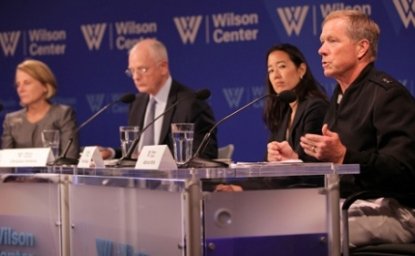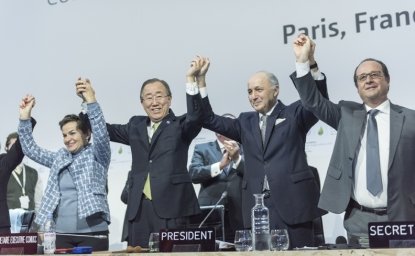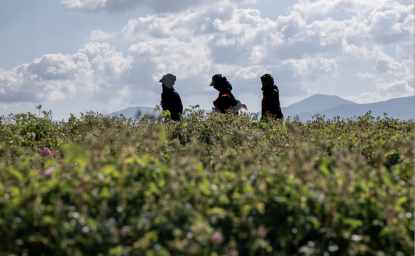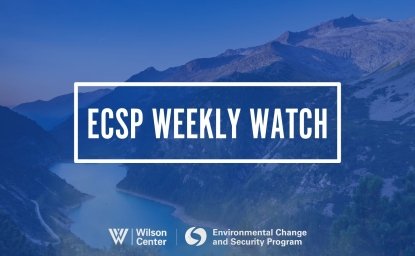Security, terrorism, conflict, and peace: you won’t find any of these words in the landmark agreement released on December 12 at the 2015 Paris Climate Conference (COP21). It’s never been front-and-center on the agenda at previous Conference of Parties, from Copenhagen to Cancun. But in Paris, a city reeling from terrorist attacks, the specter of climate-related conflict haunted delegates and the potential of a climate-resilient peace inspired grassroots protests.
In the days following the brutal terrorist attacks in Paris, confusion reigned. To the surprise of many, however, COP21 welcomed tens of thousands to the wounded city only a few short weeks later. French President François Hollande greeted delegates on November 30, saying: “I'm not choosing between the fight against terrorism and the fight against global warming. These are two global challenges we must overcome. We must leave our children more than a world free of terrorism. We owe them a planet protected from disasters…Essentially, what is at stake at this climate conference is peace.”
Climate and conflict: a complex connection
President Obama believes climate change is “a critical, urgent national security issue for our country,” Secretary of State John Kerry told NBC’s Chuck Todd during the Paris conference. At a COP21 side event with The New York Times’ Thomas Friedman, Secretary of State Kerry called the climate-related drought in Syria a “clearly destabilizing” factor that “absolutely” contributed to that country’s upheaval.
However, Kerry stopped short of drawing a direct line from climate change to terrorism: “It’s really the combination. I’m not going to sit here and say it’s all climate driven. It could be more climate-driven in the future if we don’t respond properly, because you’re going to have more massive dislocations.”
Columbia University Professor Marc Levy succinctly outlined the strong but multifaceted connections in Syria in an AMA (“Ask Me Anything”) conducted by Reddit during the COP:
There was a long, severe drought, reaching a peak in 2007-2008 that had never before been observed. The drought led to widespread loss of livestock and crops, and to difficulty getting water to cities and villages. The response to these drought impacts was a very high level of population movement in the country, along with heightened dissatisfaction with the government's handling of the problem. In areas where migrants concentrated it became even harder to provide basic services and public discord and protest grew. These were the precursors to the unrest that culminated in the current civil war….That does not mean that the Assad regime is not culpable for its aggression and persecution; it is. It means that the drought played a role in turning a country at risk of conflict into a country embroiled by conflict.
As this demonstrates, the connections between climate change and instability are complex, multifaceted, and always mediated by other pressures. A COP21 side event at the German Pavilion, organized by the German Federal Foreign Office, highlighted the results of A New Climate for Peace, a report commissioned by the G7 Foreign Ministers and recently published by a consortium including the Wilson Center. In the report, we identified seven compound risks: local resource competition; livelihood insecurity and migration; extreme weather events; volatile food prices and provision; transboundary water management; sea-level rise and coastal degradation; and the unintended effects of climate policies.
Of all of these compound risks, the links between volatile food prices and conflict is one of the most hotly debated and poorly understood. They are of compelling interest to local and national policymakers, but rarely discussed in detail at the international level.
Safeguarding food security
Clearly, food production, prices, and food security will all be significantly affected by climate change’s impact on temperatures, rainfall, and aquatic species, as outlined by Working Group II of the Intergovernmental Panel on Climate Change in its 5th Assessment report. A report released by International Food Policy Research Institute during the Paris COP predicts that climate change will have an adverse effect on food security in vulnerable countries. It cites the example of the Philippines, where it notes that climate change may increase the number of people at risk of hunger by 1.4 million in 2030 and 2.5 million by 2050.
The COP21 agreement includes explicit language on the connections between food and climate, stating it “recognizes the fundamental priority of safeguarding food security and ending hunger, and the particular vulnerabilities of food production systems to the adverse impacts of climate change.” In a nod to developing country concerns that any agreement would restrain agriculture, the agreement also states that climate adaptation and mitigation efforts would be done “in a manner that does not threaten food production.”
This carefully chosen language reflects a fundamental tension between the climate’s impact on farming, and farming’s impact on climate change. A post-COP brief from CGIAR’s Research Program on Climate Change, Agriculture, and Food Security points out that limiting warming to 1.5 degree Celsius above pre-industrial levels—advocated by some as a more ambitious alternative to the agreement’s 2.0 degree goal—would be “good news for farmers in the tropics, as they will be on the frontline of heatwaves, droughts, floods and cyclones.” However, reducing emissions from agriculture is essential, as “it will be impossible to stay within either a 1.5 or 2.0 degree C target if agriculture does not contribute to emissions reductions.”
Red flags of risk: climate, food, and conflict
It’s not nearly as clear why and how food security is linked to conflict. The relatively low profile of food-conflict connections in Paris reflects that lack of consensus.
In “A New Climate for Peace,” we agreed that climate change is highly likely to disrupt food production in many regions, raising prices and disrupting markets, and increasing the risk of protests, riots, and civil conflict, as exemplified by the 2007-9 food riots that took place in more than 40 countries. However, we cautioned that “the likelihood that food insecurity contributes to instability depends on local factors, such as the degree of urbanization and market access, and national policies, such as consumer subsidies and export markets.”
The exact interplay between prices and conflict is poorly understood. Is it sustained high prices or rapid spikes? Or perhaps it is the perception of rising prices that spurs unrest? The role of government subsidies and tariffs, as well as other market forces and policy decisions, clouds the common picture of “food riots.”
Released to little fanfare in late September, the U.S. Intelligence Community Assessment on “Global Food Security,” predicts that “in some countries, declining food security will almost certainly contribute to social disruptions or large-scale political instability or conflict, amplifying global concerns about the availability of food.” But despite having “moderate confidence” in this judgement, the authors admit that “we are unable to pinpoint the thresholds and government actions that would result in these outcomes.”
How do we begin to untangle the strands of what one former diplomat called the “spaghetti bowl” of food insecurity, climate, and conflict? We can start with more integrated analysis.
Just a few days before the Paris attacks, Kerry announced that the U.S. Department of State would work with the U.S. Agency for International Development to overlay conflict assessments with climate vulnerability analysis. This integrated climate-fragility assessment will allow the United States to identify what he called “‘red flags’ of risk”: “areas where combined risks are particularly high and where there are critical opportunities for conflict prevention and resilience before it is too late,” he said.
“The bottom line is that the impacts of climate change can exacerbate resource competition, threaten livelihoods, and increase the risk of instability and conflict, especially in places already undergoing economic, political and social stress," Kerry said in his announcement. "And because the world is so extraordinarily interconnected today—economically, technologically, militarily, in every way imaginable—Instability anywhere can be a threat to stability everywhere."
The most peaceful revolution
Task forces and assessments are only the beginning. To truly cut the cords connecting climate change, hunger, and violent conflict, we need to profoundly transform our policies, programs, and attitudes so they reflect the “extraordinarily interconnected” world we live in today.
Protest movements like “Fast for the Climate” and other demonstrators in Paris used the interconnections between food, climate, conflict, and peace as a rallying cry. Filipino climate activist Yeb Sano led 20 “climate fasters” and thousands more online in a day-long fast, telling the GroundTruth Project that unless climate goals are met, “Human conflict will become more exacerbated. We will have more refugees who escape the horror that they experience in their communities. There will be people who will be fighting for scarce resources in places where you have long droughts like Syria. It is going to get worse.”
Half a world away from Paris, in the fragile state of Nepal, almost 50 percent of the children are malnourished. In the country’s Terai region, more severe and unpredictable monsoons are ruining farmland and changing crop cycles. The Hariyo Ban Project, an innovative partnership between WWF, CARE, and Nepalese NGOs, seeks to improve climate adaptation through a holistic approach that includes not only climate vulnerability assessments, but also empowerment, education, healthcare, and family planning.
“We work with the poorest, most marginalized people and with women and communities, working on their local issues, building their self-confidence, enabling them to come to the table, to speak out in meetings, giving them self-esteem and self-confidence to do that,” Judy Oglethorpe said earlier this year at the Wilson Center. “What’s been amazing to me, managing this project, is the wide range of things we do. We do agriculture, we do disasters, we do conservation, forests, wildlife. We do health, we do education – it really just depends [on] how people are vulnerable.”
Why is Hariyo Ban able to do this, when so many other programs and policies have not? Flexible funding, said Oglethorpe, which allows them to put the needs of the community over the priorities of their funders.
Achieving the triple bottom line
The adaption funding that follows the COP21 agreement should take note of the success of truly integrated adaptation projects like Hariyo Ban. After the COP, International Alert’s Janani Vivekananda called for more funding to be devoted to integrated policies and responses that could achieve the “triple bottom line of building resilience to climate change, conflict, and poverty,” warning on the New Climate for Peace’s “Resilience Compass” against wasting precious dollars on ineffective single-sector approaches:
If we want to reduce the risk of people falling into extremism through the provision of education, training and jobs, we need to make sure that those skills and jobs are “climate-proof.” There would be little value in providing support for farming to unemployed Syrian young men when long-term drought was the reason they cannot pursue a livelihood in farming.
"Adaptation financing is the only vehicle for making COP21 relevant to security. It is important that we not squander this opportunity to design climate adaptation financing to do the most possible to help societies steer clear of the climate-triggered humanitarian crises that now plague our world,” Levy wrote in an email.
When COP21 opened on November 30, President Obama painted a frightening picture of the future if we do nothing: “Submerged countries. Abandoned cities. Fields that no longer grow. Political disruptions that trigger new conflict, and even more floods of desperate peoples seeking the sanctuary of nations not their own.”
But just two short weeks later, President Hollande closed the conference with a celebration of peace: “Today it is the most beautiful and the most peaceful revolution that has just been accomplished,” he said.
While the agreement is a major accomplishment, the revolution has only just begun. A critical next stage is to integrate climate adaptation, development and humanitarian aid, and peacebuilding efforts, with a strong focus on food security. Only then can we truly limit the risks to the planet we share and the peace we seek.
The opinions expressed here are solely those of the authors.
Roger-Mark De Souza is the Director of Population, Environmental Security, and Resilience at the Wilson Center, where he leads programs on climate change resilience, reproductive and maternal health, environmental security, and livelihoods, including the Global Sustainability and Resilience Program, Environmental Change and Security Program, and Maternal Health Initiative.
Meaghan Parker is Senior Writer/Editor for the Environmental Change and Security Program at the Wilson Center. She is currently serving her second three-year term as a board member of the Society of Environmental Journalists.
Image Source: Peacekeepers Protect Women in Rural Areas of Darfur, UN Photo (CC BY-NC-ND 2.0)



